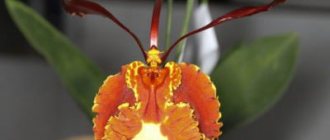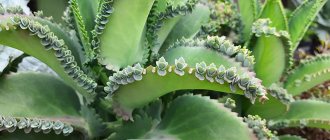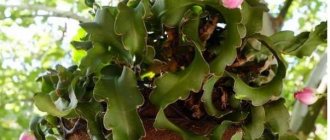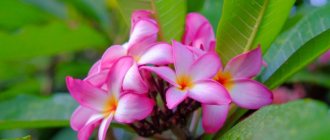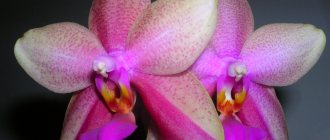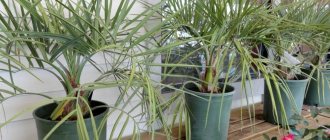Purchase and adaptation
Select a specimen with elastic leaves, without spots and drying tips. Healthy roots are succulent, green or grayish in color, without rotten or wet areas, the substrate is free of mold.
Newbie homes need to be isolated from your indoor plants. During the first 30 days, monitor it for pests. Water only after drying, when the roots become silvery, and begin feeding a month after purchase. At the end of quarantine, move the flower to a permanent location.
What is the difference from other types?
- Phalaenopsis does not have false bulbs (tuberidia).
- The substrate serves as a support, so you can use light soil.
- Blooms several times a year.
- Monopodial growth.
- The air needs more moisture.
- The flowers are always larger.
- The leaves are semicircular.
We talked in more detail about the difference between phalaenopsis and other orchids in this article.
Temperature
Phalaenopsis orchid is a tropical plant, the suitable average daily temperature for keeping is 20 -25 degrees. To set flower buds, the difference between day and night temperatures should be from 3 to 5 degrees.
Growing phalaenopsis at home
Unpretentiousness does not mean that certain care and necessary requirements for full development are not required. Therefore, there are certain recommendations that it is advisable to follow so that the flower opens in all its glory:
- location. There are no requirements for strict lighting conditions, but diffused light is considered more comfortable.
Direct sunlight can harm the leaves, so it is best to place the pet on the east or west side. Installation deep in the room will require additional lighting with phytolamps, since there is a certain length of daylight - 12 - 15 hours. This is especially true in winter, when daylight hours are too short. The first signs of a lack of lighting are elongation and noticeable thinness of the internodes of the flower. The leaf blades also become smaller and pale; - temperature regime. An orchid is a tropical plant that needs a certain humidity and temperature. A comfortable temperature for phalaenopsis is considered to be 20 - 25 ° C. The permissible temperature range is 18 - 32 °. Although some gardeners, stimulating flowering, lower it even to 12 ° and then increase it to normal values;
- humidity mode. Comfortable humidity from 50 to 80%. Even with maximum humidity, the flower, although uncomfortable, continues to develop. Humidity below 30% is considered critical - flowering stops. Also, the flower does not like spraying (sprinkling), which contributes to the development of fungal diseases. Therefore, to maintain constant humidity, the flower pot is placed in a tray filled with water;
- watering frequency. The spongy structure of the root part requires careful but moderate watering. During the dormant period, watering is reduced, but does not stop. The water should be settled or, preferably, rainwater. Its temperature should be 2-3 degrees above room temperature. A change in the color of the root system from gray or silver to green indicates sufficient watering;
- nutrition. Feeding with special mineral complexes for orchids is carried out once a month and especially during the period of active flower growth.
Important! Before feeding the orchid with any fertilizer, it should be thoroughly watered to prevent the effect of burning the root system.
Watering and fertilizers
Methods of watering orchids:
- immersion The pot is placed in a container of water;
- spillage around the edges of the pot;
- warm shower.
You can determine that moisture is needed by the color of the roots: when dry, they become silver in color. The substrate must dry completely. Use soft, settled water, otherwise salts will settle on the roots.
You need to make sure that moisture does not get into the growth point, this will provoke the development of diseases. Remove water from the outlet with a dry cloth. How and when to water a flower depends on the growing conditions.
Healthy plants are fertilized, sick and flowering ones are not. After transplantation, do not use fertilizing for a month. Fertilizer preparations are diluted according to instructions and watered well before application so as not to burn the root system.
Determining the need for humidification
The frequency of watering for phalaenopsis orchids is influenced by several factors :
- Microclimate of the room;
- Substrate quality;
- Sunlight;
- Pot quality;
- The condition of the plant itself.
Taken together, they all play an important role in the life of the trunk. Determining how often to water a phalaenopsis orchid and when to refrain is not difficult.
Roots are an excellent indicator of the need for watering.
Just pay attention:
- On the roots: a bright green color and the presence of some moisture on them indicate that it is worth holding off on watering for the next 5 days;
- Condensation on the walls of the pot indicates the same thing; watering is undesirable for such a plant. But when the droplets of moisture disappear and the substrate dries out, the orchid needs to be watered, but not very generously;
- Another indicator is considered to be the weight of a pot with a plant in a watered state and in a dry state. You can determine it correctly by simply picking up the pot after watering and remembering its weight. When a flower needs moisture, its weight will decrease significantly;
- In addition, slight wrinkling of the leaves can also be a signal to water the plant.
Important! The main factors regulating the frequency of watering are light and air temperature.
Lighting and Humidity
The process of photosynthesis requires light. It is important to choose the optimal lighting intensity. Under natural conditions, representatives of the species grow under the forest canopy, in the shade, and in the direct rays of the sun in summer, leaves and roots can get burned.
When growing tropical beauties at home in winter, special phytolamps are used for additional lighting.
If it is necessary to increase air humidity in the summer heat, or in winter during the heating season, place a container of water next to the plants and use air humidifiers.
Step-by-step instructions: how to grow?
You can make sure that this is definitely a peduncle stalk when it grows to 10 cm and takes shape. After this, fix it in a vertical position and continue to care, following the recommendations given earlier. This is necessary to obtain an even and beautiful stem. It is recommended to fix the peduncle in the following ways:
- Secure it to a support placed in a pot. Using a special clothespin, purchased in a store or made from fishing line, or a hair elastic.
- Without support. The peduncle reaches towards the light source. Rotate the container with the plant, thereby setting the direction of growth.
Video on how to secure an orchid peduncle:
Bloom
Phalaenopsis in the wild has its own development cycle. In natural habitats, the rainy season gives way to the dry season, and the time for flowering begins. With proper care indoors, the orchid grows leaves and roots, then a peduncle forms.
To keep it erect, as it grows, it is tied to a support. At this time, the development of the vegetative mass stops; no fertilizing is necessary. The blooming buds show off for several months.
If the peduncle remains green, it should not be cut. The remaining buds can form new shoots.
3. Phalaenopsis varieties
It is very difficult to describe all varieties of phalaenopsis - after all, there are a great many of them, let’s look at just a few.
3.1. Schiller's Phalaenopsis - Phalaenopsis schilleriana
A profusely blooming species with large, pink flowers on drooping stalks that have a rose scent. The homeland of the plant is the Philippines. It has become widespread due to its unpretentiousness and tolerance to low lighting levels. An excellent hanging plant, which during the flowering period will hang large branched flower stalks with a cascade of pink flowers over the edges of a hanging flowerpot.
↑ Up,
3.2.Phalaenopsis Sogo - Phalaenopsis Sogo
A small, compact, large-flowered orchid with very bright colors of buds in all colors of the rainbow. Among this variety there are variegated plants with yellow longitudinal stripes on thick, fleshy leaves. The orchid's peduncles are strong, erect, and during the flowering period the plant emits a very pleasant aroma.
↑ Up,
3.3. Phalaenopsis Liodoro - Phalaenopsis Liodoro
A miniature multi-flowered subspecies with bright, soft, green leaves and short, often drooping flower stalks. The flowers are very brightly colored - the edges of the petals have a yellow tint, and towards the center they are abundantly covered with small specks, merging into a solid pink or lilac tone.
↑ Up,
3.4.Phalaenopsis Mini Mark
A very beautiful, small-flowered plant, reaching a height of only 10 - 15 cm. The leaves are dark green, relatively large, glossy, slightly bent along the central vein. The peduncles are tall and thin, bearing small flowers at the top with white oblong petals covered with red or pink specks - freckles. The lower lip is painted a bright orange shade.
↑ Up,
Transfer
After the end of lush flowering, you can begin the transplantation procedure. Usually the reason is the removal of transport soil or the growth of the root system, the need to replace salted pieces of bark.
To ensure the process of photosynthesis in the roots of the epiphyte, the substrate must be:
- loose;
- moisture-absorbing;
- breathable;
- light.
You can find a ready-made mixture for orchids on sale. The composition includes: the main component is pine bark, sphagnum, charcoal, coconut chips or fiber, peat. If the soil is prepared independently, it is important to consider the following points: the collected bark must be disinfected and the resin and tannins removed from it.
Choosing a pot is another difficult task for a novice gardener. The best option is a transparent container with many holes for water drainage and root aeration.
The assortment on store shelves is presented in the following options:
- plastic transparent pots - simple, with drainage holes;
- colored translucent - the light necessary for the roots penetrates them;
- “crown” system - more suitable as a flowerpot for a pot;
- ceramics or glass - delicate roots grow to the walls, you need to properly regulate the amount of moisture in the soil; this growing method is not recommended for beginners.
During transplantation, the plant is removed very carefully, trying not to damage the fragile roots. Thin threads without velamen, blackened areas are removed with a sterile instrument.
Check to see if there is a plastic cup under the neck; if it is in the way, it should be carefully removed. The roots are distributed in a new pot, the aerial ones are also placed, if possible, and the substrate is added.
And then they simply leave the transplanted plant alone and give it time to adapt. Abundant watering and fertilizing during this period will have a detrimental effect.
Where and for how much can I buy it?
You can buy phalaenopsis in specialized flower shops and supermarkets.
The plant can also be purchased from gardening societies and clubs, at gardening exhibitions, from amateur gardeners and remotely. The best time to select a butterfly orchid is when it is in bloom .
Particular attention should be paid to the leaves: there should be no suspicious spots or signs of wilting on them. The roots of a healthy Phalaenopsis are strong and may protrude slightly.
The plant must sit firmly in the ground . If it wobbles, its root system is not viable and it is not worth buying such a specimen.
Price (price region - Moscow, St. Petersburg) - from 800 to several thousand rubles per copy.
Reproduction
The first purchased specimens have taken root in the apartment, they delight us with their flowering, now it’s time to master the techniques of propagating graceful beauties.
In its natural habitat, the ornamental crop reproduces by dusty yellowish seeds. At home, if you have a strong desire and patience, you can take care of flowering plants, carry out pollination yourself, and collect seeds after 5-6 months. Growing seed material is carried out in a prepared sterile environment; the process is complex and lengthy for breeders and advanced collectors.
Other propagation methods:
- children;
- cuttings from flower stalks.
Children appear on the peduncle, on the trunks (if the main growth point has died), between the leaves. The babies are not separated from the mother plant until they have grown several leaves and their own roots to ensure independent life.
After flowering has finished, cuttings are cut from the peduncles. They can be rooted in homemade plastic greenhouses. If successful, the root formation process lasts about a month.
Plant characteristics
Scientific name: Phalaenopsis Orchid - Phalaenopsis. Genus, family: Orchidaceae - orchids. Origin: East Asia, India (mainly tropical forests with a hot climate).
The genus Phalaenopsis belongs to the Orchid family. The Phalaenopsis orchid, as a separate genus, was first described by the German botanist Carl Ludwig Ritter von Blume in 1895. The natural habitat of these plants is the wet plains and montane forests of North-Eastern Australia, Southeast Asia, and the Philippines. The Phalaenopsis orchid is an epiphytic plant with a long stem and three to five large fleshy leaves arranged in two rows. At home, many different types of phalaenopsis are known (there are up to 70 different species, as well as a large number of artificially grown hybrids), which differ in the color of the inflorescences, the size of the leaves and the shape of the petals.
The flower got its name from two Greek words phalania (“night butterfly”) and opsis (“resemblance”), since the flowers resemble velvet butterflies in their appearance.
There are two main types of Phalaenopsis - ordinary (whose length is up to 1 m) and miniature - which do not grow more than 30 cm. The stem of the plant is vertical, often very shortened, the leaves are wide, shiny and leathery, collected in a rosette. The plant produces aerial roots and flower stalks from the axils between the leaves. The number of leaves in an adult plant, as a rule, ranges from 4 to 6, their length is 5-30 cm. Characteristics of peduncles are long, axillary, and often branched, in most species with a large number of large flowers.
The flowers of the Phalaenopsis orchid themselves are of various sizes and shapes, while corresponding to their name and resembling exotic butterflies. The coloring comes in very different variants - both one-color - white, red, pink, purple yellow, and striped, two-color, speckled. The lip of a contrasting color usually stands out effectively against the background of the petals. The duration of flowering on average is up to 4 months, which also depends on the type and variety of Phalaenopsis, which under favorable conditions can bloom even 2-3 times a year.
Growing Phalaenopsis indoors occurs either in plastic pots (in most cases, transparent, for better access to light), or using the block culture method. As already mentioned, maintaining a Phalaenopsis orchid is not difficult, which is why it is suitable both for expert gardeners and for those who are just beginning to master this wonderful art.
Phalaenopsis elements: baby, peduncle, root
At the initial stage of their growth, the root, peduncle and baby of Phalaenopsis are quite similar to each other, therefore, to help you recognize them, we will point out the difference between them.
So, the peduncle is the most important thing in the plant. Simply put, it is the trunk from which flowers later grow. It emerges from the center of the plant, where the central vein of the entire flower originates. It is always directed strictly upward, and its tip is usually sharp.
The root, unlike the peduncle, can grow from any place on the base of the plant, even from the very center. Most often its growth is downward, but it can also grow upward or sideways. The root tip is always rounded. There is a possibility that on your Phalaenopsis you will find something that will not look like a root or a peduncle; in this case, your Phalaenopsis has decided to have a basal baby.
What is it baby? This is a new mini plant that has its own leaves, roots, etc. The baby appears from where the peduncle usually appears, that is, from the center of the trunk. Its tip is also sharp and directed upward. How to distinguish them is very simple, you will understand everything by their appearance.
Phalaenopsis propagation options
One of the important elements in caring for a Phalaenopsis orchid is the process of its reproduction. There are 2 options for orchids - seeds or babies.
The first option is in most cases used by breeders to obtain new varieties, species and hybrids. It is impossible under normal home conditions, so we will not describe it in detail, but will immediately move on to the one that you can apply yourself - to reproduction by children.
A phalaenopsis baby can appear in two ways - on the stem in the axils of the leaves or from dormant buds (meristems) on the peduncle. At times, their appearance is possible independently without human intervention. However, most often, in order to produce babies, the meristems have to be stimulated.
It is important to warn that only healthy Phalaenopsis with good roots and the number of leaves reaches at least 4 can be propagated.
Speaking of stimulation, it is worth saying that we will tell you about this only by briefly describing them, since each of these methods requires a long and detailed description, which you will find in our next articles on the propagation of the Phalaenopis orchid. So, there are 5 ways:
- placing the cut peduncle in a closed transparent container (greenhouse) with a small amount of water and fertilizer;
- stimulation of the buds by “drought” and temperature changes (that is, creating a stressful situation for the plant);
- dividing an adult plant (since cutting the top always stimulates dormant buds on the stem that remains);
- cutting the peduncle into several parts with dormant buds in the middle and placing them in a greenhouse;
- stimulation of the buds on the peduncle with hormonal paste.
Despite the fact that all methods are very different from each other, there are general principles for all that must certainly be followed. Among them there are two main ones. The first is that for effective stimulation it is necessary to create an environment of high humidity and temperature (+25-30°C, or even better +28-30°C), as well as provide good lighting. And the second is that to enhance the effect, it is worth adding nitrogen fertilizer, which will stimulate foliage growth. If you decide to ignore these conditions, then your result will most likely be zero, so it is very important to remember them and comply with them.
A few words about the types of Phalaenopsis orchids
Here you can find descriptions of all subspecies, but a little below we will talk about several in more detail. Now is the time to tell you about all the varieties of Phalaenopsis orchids. If you thought that Phalaenopsis does not have its own subspecies, you were deeply mistaken. Our description will help you understand what kind of Phalaenopsis you have in your home, or it will help you choose which species you would like to purchase.
Schiller's phalaenopsis (Phalaenopsis chilleriana). One of the most common Phalaenopsis, which simply drives all orchid lovers crazy with its appearance.
He himself is from the Philippines. Phalaenopsis Schiller has very interesting variegated leaves, which are distinguished by a silvery coating on top, with dark green spots merging into stripes. It is from this Phalaenopsis that a large number of hybrids come. A very interesting difference of this genus is the huge number of flowers on one peduncle. History records a case when this number reached 174. It blooms for several months, several times a year. Phalaenopsis amabilis, another name is Phalaenopsis Pleasant. It is characterized by large inflorescences, curved branches, on which 15-20 flowers usually grow, the diameter of which reaches 11 cm. The color is usually white, with a yellow or purple color on the lips of the flower. Sometimes you can smell a pleasant aroma emanating from the flowers of this species.
Phalaenopsis Stuartiana. This species, in general terms, has many similarities with Schiller's Phalaenopsis. Its homeland is also the Philippines. The peduncle is distinguished by the fact that it is branched, and the flowers themselves have a specific pattern. These Phalaenopsis are white with reddish spots at the base of the sepals, the lip is golden yellow with purple spots. The flowers themselves are small. Flowering period: spring and autumn. Phalaenopsis lueddemanniana. This is an interesting species, blooming mostly all year round, but having a peak flowering in the winter, from December to March. The peduncles are small; they usually contain up to 7 small flowers, which open alternately. They boast a very delicate pink-violet tone. In the middle, the tone becomes brighter. The lip of this species is white, with purple and yellow hues. One of the noticeable differences is a very pleasant aroma.
Pink phalaenopsis (Phalaenopsis rosea). One of the smallest species. In the Philippines, such beauty most often grows on the banks of rivers. The short peduncle is usually decorated with 15-20 small flowers, opening one after another and having a very delicate white-pink color. The sepals themselves are oblong and pink, with white vertical stripes, the lip is small, having three lobes, the color of which smoothly changes from pink to dark purple. Phalaenopsis sanderiana. One of the rarest and most expensive Phalaenopis. The name of this species comes from the name of the famous gardener and huge admirer of orchids - Sander. The leaves of Phalaenopsis Sander are dark green with a variegated pattern. The peduncles are usually long, leaning down, on the opposite rows of which there are an average of 50 flowers, the diameter of which is 5-7 cm. The color is very varied. Phalaenopsis equestris. The most suitable Phalaenopsis species for those who are fans of dark violet and purple colors, since it is the richness of the color that first attracts the attention of lovers of this species. The peduncle of the plant gradually lengthens and grows over time, at the end of which more and more new flowers constantly appear, the diameter of which becomes only 2-3 cm.
Giant phalaenopsis (Phalaenopsis gigantea). Very interesting view.
As the name implies, it is the largest representative of the Phalaenopsis genus. At times it is also called the most spectacular. This giant Phalaenopsis received its name in honor of its huge leaves, the size of which reaches 90 cm in length. It is perfect for crossing. The stem of this species is not so easy to see, since it is entirely hidden under the bases of the leaves. The leaves are huge, leathery, drooping. The peduncle is also drooping, rarely branched, length - about 40 cm, number of flowers - 10 - 30. Usually an adult plant has several peduncles, which together can boast of the presence of about 100 round-shaped flowers. The aroma is sweetish citrus. The color is cream, yellow and greenish-yellow, with raised reddish-brown spots or streaks. Taking into account the size of the plant, we can say that this is not the best Phalaenopsis option for home conditions, but it is perfect for greenhouses with sufficient space. In conclusion, it is worth recalling that the Phalaenopsis orchid has always been considered an exquisite plant that delighted its owner with beauty and aroma, bringing aesthetic pleasure regardless of the species. With proper care, any Phalaenopsis can look amazing and make every day more beautiful. You can read more about all types here. Additional articles about this species:
- Care for Phalaenopsis;
- Replanting Phalaenopsis;
- How to make Phalaenopsis bloom;
- Signs of orchid diseases.
Rejuvenation
In an elongated bush with a large number of aerial roots, the upper part with leaves and roots is cut off with a sharp sterile pruning shears. Leaves are also left on the mother plant; children will develop on the old trunk.
The cut part is dusted with crushed coal or cinnamon, dried, and planted without deepening so that the root collar does not become damp.
A detailed description and step-by-step instructions with photos for propagating the Phalaenopsis orchid can be found on websites for gardeners; it’s easy and exciting.
Pests
- Tick . It affects the leaves and buds of the plant, you may see thin webbing and small white dots. Acaricides are used for destruction.
- Aphid . You can see it on the underside of the leaf - it is a white coating.
- Scale insects and scale insects . If your plant (stems, leaves) begins to become covered with small light yellow spots turning brown, and sticky black spots appear on the leaves, you need to immediately begin treating the plant with phytoverm.
- Thrips . When infected, black dots of excrement can be seen on the leaves, the color changes to silver, and later the infected areas will darken. For treatment, insecticides must be used.
Phalaenopsis is ready to please you constantly, requiring only minimal care in return.
Maintain temperature conditions and water properly, protect the plant from direct sunlight. Do not make mistakes in caring for phalaenopsis and then phalaenopsis butterflies will regularly flutter in your flower garden. To make your flower garden even more beautiful, place several pots of these wonderful flowers in it, and you simply won’t need others.
We invite you to watch a video about diseases and pests of orchids:
Once every 2-3 years, the orchid needs to be replanted. Read about when is the best time to replant a plant and how to plant a root child.
Errors in care
The most common errors:
- watering with cold, hard water;
- frequent watering without breaks for drying;
- choosing the wrong place - lack or excess of lighting, drafts;
- overdoing the application of fertilizers.
After eliminating these errors, the orchids will thank you for your attention with a wave of luxurious flowering.


